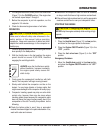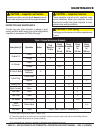
PAGE 16 — MVC-82VH/VHW PLATE COMPACTOR • OPERATION AND PARTS MANUAL — REV. #1 (04/25/08)
INSPECTION
Figure 3. Engine Oil Dipstick (Removal)
Figure 4. Engine Oil Dipstick (Oil Level)
BEFORE STARTING
1. Read safety instructions at the
beginning of manual.
2. Clean the compactor, removing
dirt and dust, particularly the
engine cooling air inlet,
carburetor and air cleaner.
3. Check the air filter for dirt and dust. If air filter is dirty,
replace air filter with a new one as required.
4. Check carburetor for external dirt and dust. Clean with
dry compressed air.
5. Check fastening nuts and bolts for tightness. Loosened
screws or bolts due to vibration, could lead to
unexpected accident.
ENGINE OIL CHECK
1. To check the engine oil level, place the pump on secure
level ground with the engine stopped.
2. Remove the filler dipstick from the engine oil filler hole
(Figure 3) and wipe clean.
3. Insert and remove the dipstick without screwing it into
the filler neck. Check the oil level shown on the dipstick.
4. If the oil level is low (Figure 4), fill to the edge of the oil
filler hole with the recommended oil type (Table 4).
Maximum oil capacity is 0.63 quarts (0.60 liters).
FUEL CHECK
1. Remove the gasoline cap located on top of fuel tank.
2. Visually inspect to see if the fuel level is low. If fuel is
low, replenish with unleaded fuel.
3. When refueling, be sure to use a strainer for filtration.
DO NOT top-off fuel. Wipe up any spilled fuel
immediately!
epyTliO.4elbaT
nosaeS erutarepmeT epyTliO
remmuS rehgiHroC°52 03-W01EAS
llaF/gnirpS C°01~C°52 02/03-W01EAS
retniW rewoLroC°0 01-W01EAS
The Oil Alert System will automatically
stop the engine before the engine falls
below safe limits. Always be sure to check
the engine oil level prior to starting the
engine.
DANGER — Explosive Fuel Hazard
Adding fuel to the tank should be done
only when the engine is stopped and has
had an opportunity to cool down. In the
event of a fuel spill, DO NOT attempt to
start the engine until the fuel residue has
been completely wiped up, and the area surrounding
the engine is dry.


















